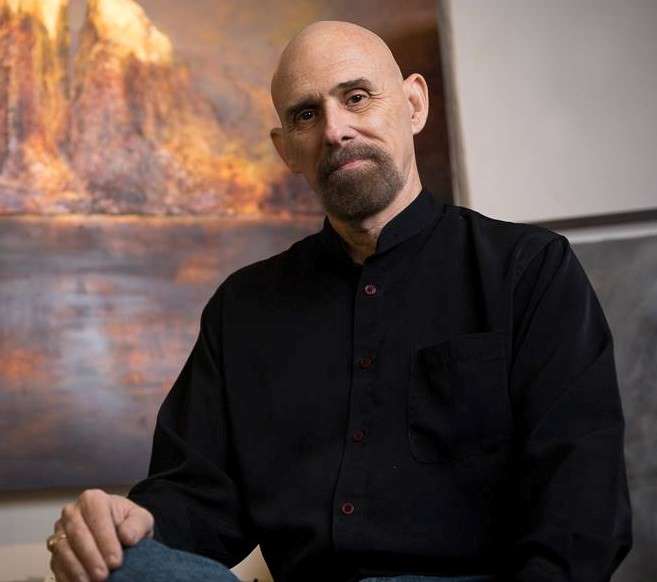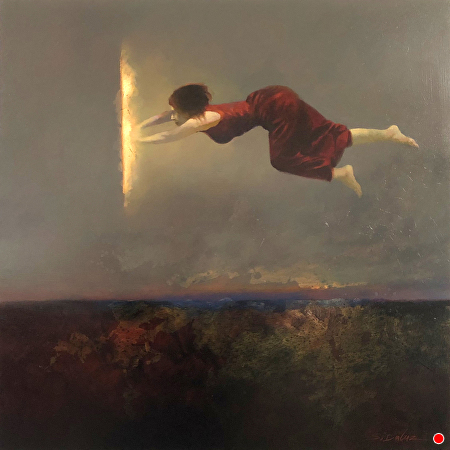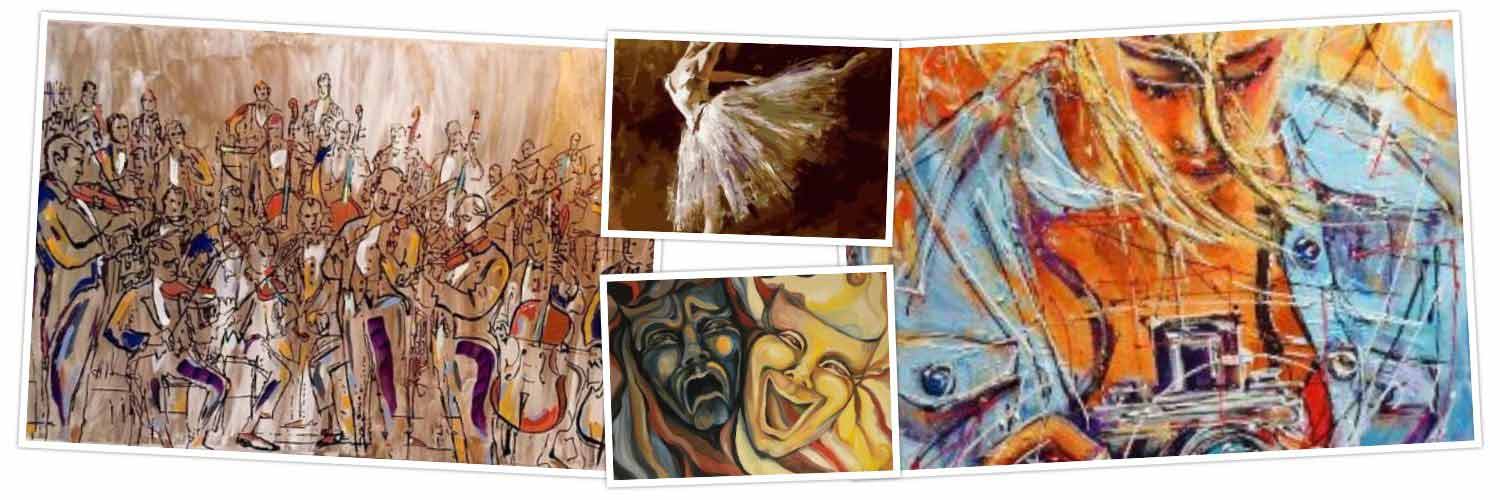Steven DaLuz, Artist
By JASMINA WELLINGHOFF, Editor
(We interviewed DaLuz at the AnArte Gallery where his new exhibit “Between Worlds” is currently on view through May 31)
How do you describe yourself as an artist and your style?
I am someone who cannot not paint. Painting is my way of communicating, my way to express things that I cannot quite say with words. As for my style, I have been spoken about as a luminist. That’s a style from the 1800s and those painters were primarily landscape painters. I am compared sometimes to them, but I don’t believe I am really a Luminist in that tradition. I have also been described as a contemporary Luminist in Wikipedia. I look with a more contemporary eye on a scene. But whether it’s a landscape that I made up or a figure that I place in a space, it’s always about the light.

I really like to focus on the sublime. There are different theories about it. Emanuel Kant spoke about it, and then you have Edmund Burke who also spoke of it. My idea of the sublime is closer to Edmund Burke’s understanding of the sublime as something that occurs in nature and inspires a sense of awe. It juxtaposes man against nature. We are tiny against the power of nature. If you go to the edge of a massive cliff, and you look down and you begin to take a step right at the precipice, that feeling that you would get just before falling, is what I like to describe as the sublime… In a painting there’s no actual danger. You are looking at a moment frozen in time and maybe you get a sense about the smallness of yourself. So, that interests me.”
Tell us more about how you developed an interest in the sublime?
That’s a real good question. It seems to me, there’s so much more to life than the mundane things we do and face from day to day – going to work, reading a book, going to the grocery store… I found myself thinking about things outside of this life, something more than the existence we have here. My interest came out of this desire for something more, something outside of the corporeal.
This exhibit is a stunning expression of that intellectual and spiritual search. Can you tell us more about the paintings?
The idea behind this show is to imagine the transitioning between states of being, between the present moment and the future, between the physical and the spiritual, between one dimension and another, possibly. There’s so much about the universe that we don’t understand and can’t even begin to comprehend because our senses are so limited. I start imagining the possibility of traveling in an instant from this realm that we are in now to some other world.

Some of your earlier images show a lot of human figures – mostly women – with wings. Were those images related to the current questions you are considering?
In an earlier series, called” Watchers,” I delt with that subject and there were a lot of wings. Wings don’t have to be taken literally. I am not saying that these figures are angels. They are human but some things are going on within their minds. They appear to levitate. They are in a state that can be described as euphoric or transcendent.
Let’s talk about your technique?
Many years ago, I realized that I couldn’t get a sense of light that I was looking for in my work by simply layering light-colored paint. The best I could do is have the painting reflect the light that was hitting it. So, I asked myself, what would happen if I used a more reflective material to begin with, so when light hits it, the effect is bigger. I developed a process where I use gold, copper leaf, composition gold leaf, and I seal the surface really well. When I layer the paint on top of all this, I usually use transparent colors. As the light passes through the paint, it bounces off of the metal and gives me light that looks like it’s coming from inside the painting. I really like that.
Would you describe yourself as a “contemporary painter”?
That word is loaded, isn’t it? In the art world the term is used to mean something quite different from its obvious meaning. In that definition of “contemporary,” I probably don’t fit in that niche. I am a contemporary figurative artist but I am not a “conceptual” artist. I am not nihilistic in the work that I do and I stay away from political narratives in my work.
How did you become an artist?
I don’t think it’s something that you become, at least for me. It’s something that was always there. From my earliest memories, I was always interested in drawing, coloring and marking up the walls. I never really questioned why I had the desire to draw. I liked doing it and I thought everyone else did, too. Later on, I realized that was not the case. But for me, it was an organic development. Over time, of course, you try to learn as much as you can, so that you can more clearly express what you are trying to express with your artwork.
Your paintings are in demand. Almost all in the current exhibit have already been sold. Are you able to make a living with your art?
I am a retired Air Force officer. I retired after serving almost 25 years. I did not pick up a paint brush until I was about 44, even though I have been drawing my whole life. (He also has a fine arts degree and degrees in management and social psychology).

We learned that one of your paintings is headed to the Moon. Tell us about that.
Some years ago I was invited by the editor of Poets & Artists magazine to curate an issue for her. She knew I was a big collector of drawings and I was invited to work on the issue called “100 Great Drawings.” That work allowed me to connect with fantastic artists from all over the world. It was difficult to narrow down the choice to just 100 works. That was all done and published in 2016. Earlier this year, I received a note about a listing on Facebook of artists whose work was going into a time capsule to be sent to the Moon. When I saw my name listed, I thought it was a joke. But it’s true. There’s a gentleman named Dr. Samuel Peralta, a scientist who loves art, from the Philippines, but works in Canada. He selected the issue I curated for Poets & Artists, and another issue that contains my work for inclusion in the first commercial lunar lander to land on the Moon. It’s supposed to land on the surface of the Moon in July. (His digitally stored work will be one of 1,200 in the capsule.) So, now, when I look at the moon, it will have a different significance for me. (Laughs)
How has the pandemic affected you as an artist and as a person?
I was able to continue my works which anyway is a solitary pursuit. But I think it has affected some of my creativity in the sense that I got a bit of an artist block, because I was so preoccupied with all these other things affecting my life. My wife works in a hospital, in surgery, so she was dealing with COVID from the early stages and coming home at night with those stories.

Have you learned something from this difficult year-long experience?
Yes, how wonderful it is to meet someone face to face, to look at their facial expressions and see their smile.
You mentioned that you are a spiritual man but have not always been one. Could you elaborate?
When I was in the Air Force, I saw a lot of death and human suffering. It affects you over time. Those kinds of experiences led me to more spiritual things. I felt, there’s got to be something more than what is happening here, more than this physical life that we have.
You have three children. What advice from you would you like them to remember?
I want them to treat people the way they would like to be treated. If you can do that, everything else falls into place.
San Antonians recently voted on Proposition B that was expected to bring some positive changes in local policing. Where do you stand on that?
You ask me some really tough questions! I’ll answer it this way: I could not vote because I don’t live within the city limits. But that’s the only reason.
I am troubled by the current political climate of deep division, a lot of it caused by the media. They sell their product by presenting the bad news, pitting one side against the other… I don’t like the vilification of the police. Can there be improvements? Of course. But a wholesale action to dismiss entire institutions is really troubling to me.
What makes you laugh? (He laughs upon hearing the question.)
Sometimes I laugh at myself. Humor is a beautiful thing. I like self-deprecating humor. Also, certain things that animals do. Sometimes they do these zany things that just crack you up.
What makes you angry?
Being lied to by our leaders; being lied to, in general. But the thing that makes me angriest is adults taking advantage of young children.
If you could be the King of San Antonio, what changes would you implement?
Thank God I am not the King of San Antonio! (Laughs) What changes? For one, I wouldn’t vilify the police. I would fix all the freaking potholes all over the place. I probably would redesign some streets so that they make sense. I hate driving on a street that changes its name three or four times. Also, I would be more creative with street names. I think we have five Military Drives in the city that don’t even connect to each other. And I would respect the Constitution. Either we are a nation of laws or we aren’t. If an issue is important, let people vote on it.
Is there something that you have always wanted to do but have not had a chance to actually do?
I do like to travel. Some day I would like to take my wife to New Zealand and a few other countries. I also want to make that one special painting that says what I want to say, and calls upon the full spectrum of my skills, a painting that someone will look at 100 years from now and think of it as a masterful work, my definitive piece. But then, I would be done painting, so that definitive painting will probably always be on the far horizon.

Beautiful work!